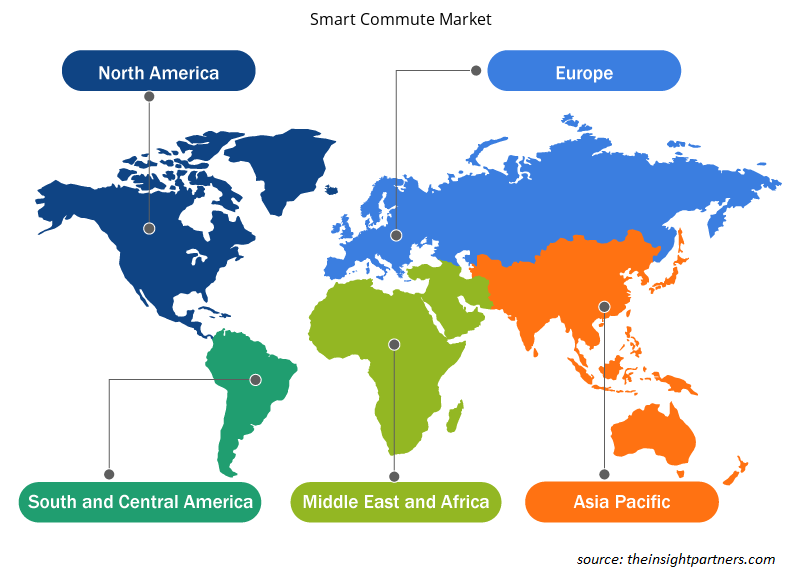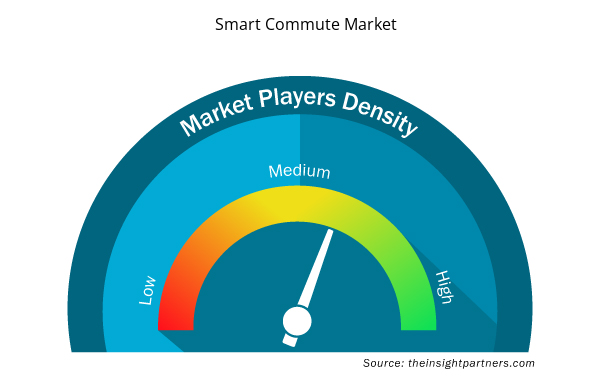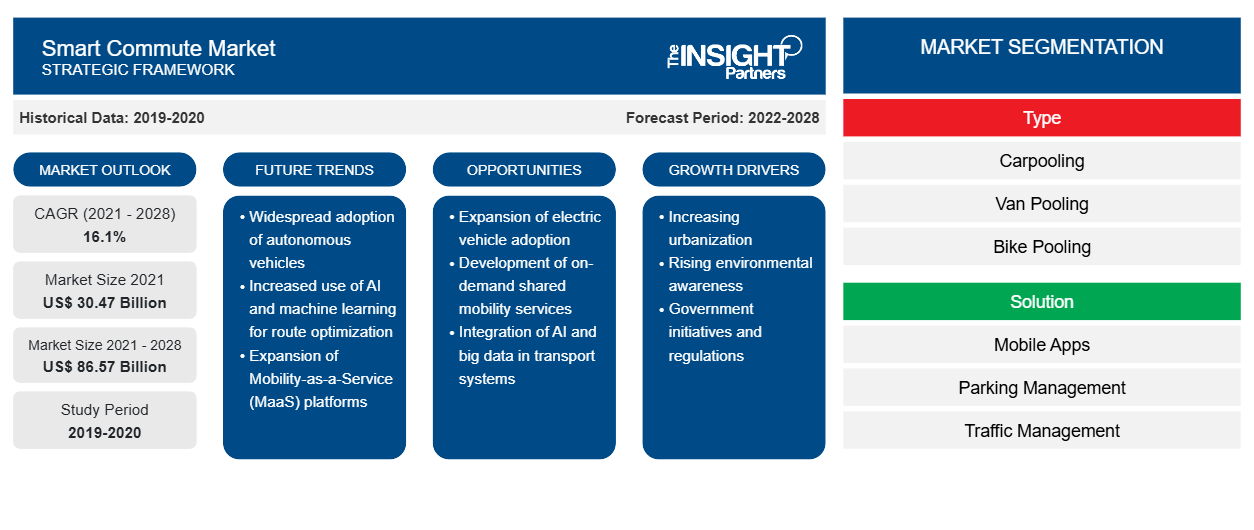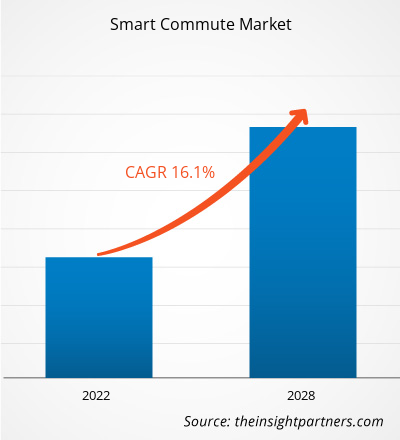Der Markt für intelligentes Pendeln soll von 30.469,49 Millionen US-Dollar im Jahr 2021 auf 86.568,73 Millionen US-Dollar im Jahr 2028 wachsen; von 2021 bis 2028 wird mit einer durchschnittlichen jährlichen Wachstumsrate von 16,1 % gerechnet.
Unter intelligentem Pendeln versteht man regelmäßiges Reisen in Fahrgemeinschaften, Vanpooling , mit dem Fahrrad oder mit dem Rad oder mit der U-Bahn. Öffentliche Verkehrsbetriebe, Regierungen und andere Interessengruppen haben eine umfassende Strategie entwickelt, die intelligentes Reisen berücksichtigt und der Öffentlichkeit zugänglich macht, um leistungsfähigere Transportmittel in Metropolregionen zu schaffen. Intelligentes Pendeln wirkt sich positiv auf die Umwelt aus, indem es Verkehrsstaus verringert und Treibhausgasemissionen reduziert.
Fahrgemeinschaften, Bike-Sharing , Vanpooling und andere umweltfreundliche Pendelmöglichkeiten sind über Smart-Commute-Dienste verfügbar. Sie bieten Büroangestellten eine Transportmöglichkeit, um einen effektiveren Pendelweg zu wählen, der Verkehrsstaus und Transportkosten reduziert. Einer der Faktoren, die das Wachstum des Smart-Commute-Marktes ankurbeln, ist die wachsende Zahl von Stadtbewohnern, die zu einem Anstieg der Generationenraten führt. Gemeinsame Transportdienste haben allgemeine Akzeptanz gefunden und werden von Regierungen und Umweltorganisationen gefördert, da sie zur Reduzierung von Emissionen beitragen. Sie ermöglichen weniger Privatautos, was das Wachstum des Smart-Commute-Marktes in den kommenden Jahren voraussichtlich ankurbeln wird.
In Nordamerika wurde der Bedarf an intelligenten Pendeldiensten durch die zunehmende Vorliebe von Pendlern für Fahrgemeinschaftsdienste angeheizt , die Verkehrsstaus verringern und Umweltschäden vorbeugen würden. Darüber hinaus sind ein Anstieg der Tourismusbranche, technologische Fortschritte und eine günstige Regierungspolitik weitere Faktoren, die das Wachstum des nordamerikanischen Marktes für intelligente Pendeldienste vorantreiben . In Europa dürften der zunehmende Trend zu Mobilität als Dienstleistung und die wachsende Nutzerbasis von Mitfahrdiensten lukrative Möglichkeiten für die Marktteilnehmer schaffen.
In Europa erfreuen sich Smart Commuters aufgrund wachsender Sorgen über die globale Erwärmung, Verkehrsstaus und die Abhängigkeit von ausländischer Energie zunehmender Beliebtheit. Die 2012 eingeführte Praxis, Mautgebühren für Autos mit nur einem Insassen zu erheben, hat zu einem enormen Anstieg der Nutzung von Smart Commutes durch europäische Verbraucher geführt.
Passen Sie diesen Bericht Ihren Anforderungen an
Sie erhalten kostenlos individuelle Anpassungen an jedem Bericht, einschließlich Teilen dieses Berichts oder einer Analyse auf Länderebene, eines Excel-Datenpakets sowie tolle Angebote und Rabatte für Start-ups und Universitäten.
- Holen Sie sich die wichtigsten Markttrends aus diesem Bericht.Dieses KOSTENLOSE Beispiel umfasst eine Datenanalyse von Markttrends bis hin zu Schätzungen und Prognosen.
:
Auswirkungen der COVID-19-Pandemie auf den Smart Commute-Markt
Der COVID-19-Ausbruch hatte erhebliche Auswirkungen auf den Transportsektor. Die Nachfrage nach Fahrgemeinschaften und Vanpooling -Diensten ging im Jahr 2020 aufgrund von COVID-19 weltweit zurück. Der weltweite Smart-Commute-Markt verzeichnete im Jahr 2020 im Vergleich zu 2019 einen erheblichen Umsatzrückgang, was teilweise auf die Lockdowns und die Zurückhaltung der Kunden zurückzuführen ist, Mitfahrdienste auch nach Aufhebung der Beschränkungen zu nutzen. Mitfahrunternehmen versuchen stets, das Vertrauen von Fahrern und Passagieren in Bezug auf Sicherheit und Hygiene aufrechtzuerhalten.
Markteinblicke – Smart Commute-Markt
Zunehmender Trend zu Mobility-as-a-Service
Menschen, die sich kein Auto leisten können, können dank Mobilitätsdiensten problemlos reisen. Laut dem Bureau of Transportation Statistics betragen die durchschnittlichen Kosten für den Besitz und Betrieb eines Fahrzeugs etwa 8.858 US-Dollar, wenn man von 15.000 gefahrenen Kilometern pro Jahr ausgeht. Mobility-as-a-Service senkt diese Kosten für den Benutzer, indem es die Nutzung von Transportdiensten wie Fahrgemeinschaften und Mitfahrdiensten maximiert. Es reduziert auch Verkehrsstaus und die Gesamtautoemissionen in Städten. Infolgedessen verwalten digital unterstützte Fahrgemeinschaften und Mitfahrdienste den Transportbedarf effizient und bieten eine bequeme und umweltfreundliche Alternative zum privaten Autobesitz. Darüber hinaus leben laut Statistik derzeit 55 % der Weltbevölkerung in Städten, und Schätzungen gehen davon aus, dass bis 2050 etwa 68 % der Bevölkerung in Städten leben werden. Die rasante Urbanisierung führt bereits zu Verkehrsstaus. Das Konzept Mobility-as-a-Service (MaaS) könnte eine bessere Wahl zur Reduzierung von Verkehrsstaus sein, indem die vorhandene öffentliche und private Verkehrsinfrastruktur stärker genutzt wird. Der dringende Bedarf an effektiven Lösungen zur schnelleren, kostengünstigeren und bequemeren Verkehrsabwicklung in Smart Cities dürfte das Wachstum des MaaS-Marktes bis 2028 ankurbeln. Daher wird erwartet, dass der zunehmende Trend zu Mobility as a Service (MaaS) das Wachstum des globalen Marktes für intelligentes Pendeln ankurbelt.
Markteinblicke zum typbasierten Smart Commute
Der Markt für intelligentes Pendeln ist nach Typ in Fahrgemeinschaften, Vanpooling, Fahrradpooling, U-Bahn und andere unterteilt. Es wird erwartet, dass das Fahrgemeinschaftssegment einen bedeutenden Anteil am globalen Markt für intelligentes Pendeln hat und mit der höchsten durchschnittlichen jährlichen Wachstumsrate wächst. Intelligentes Pendeln wird definiert als regelmäßiges Reisen von einem Punkt zum anderen per Fahrgemeinschaft, Vanpooling, Fahrrad, mit dem Rad oder mit der U-Bahn.
Lösungsbasierte Einblicke in den Smart Commute-Markt
Basierend auf der Lösung ist der Markt für intelligentes Pendeln in mobile Apps, Parkraummanagement , Verkehrsmanagement und andere unterteilt . Es wird erwartet, dass das Segment der mobilen Apps einen bedeutenden Anteil am globalen Markt für intelligentes Pendeln hat und mit der höchsten durchschnittlichen jährlichen Wachstumsrate wächst. Es gibt eine zunehmende Nutzung mobiler Anwendungen im Autoreisemodus, um Reisezeit, Kosten und Fahrzeugabgase zu reduzieren.
Endbenutzerbasierte Markteinblicke in intelligentes Pendeln
Basierend auf dem Endnutzer ist der Markt für intelligente Pendeldienste in Privatpersonen und Unternehmen unterteilt. Das Segment Unternehmen wird voraussichtlich einen bedeutenden Anteil am globalen Markt für intelligente Pendeldienste halten und voraussichtlich mit einer höheren durchschnittlichen jährlichen Wachstumsrate wachsen.
Regionale Einblicke in den Smart Commute-Markt
Die regionalen Trends und Faktoren, die den Smart Commute-Markt im Prognosezeitraum beeinflussen, wurden von den Analysten von Insight Partners ausführlich erläutert. In diesem Abschnitt werden auch die Marktsegmente und die Geografie des Smart Commute-Marktes in Nordamerika, Europa, im asiatisch-pazifischen Raum, im Nahen Osten und Afrika sowie in Süd- und Mittelamerika erörtert.

- Holen Sie sich regionale Daten zum Smart Commute-Markt
Umfang des Marktberichts zum intelligenten Pendeln
| Berichtsattribut | Details |
|---|---|
| Marktgröße im Jahr 2021 | 30,47 Milliarden US-Dollar |
| Marktgröße bis 2028 | 86,57 Milliarden US-Dollar |
| Globale CAGR (2021 - 2028) | 16,1 % |
| Historische Daten | 2019-2020 |
| Prognosezeitraum | 2022–2028 |
| Abgedeckte Segmente | Nach Typ
|
| Abgedeckte Regionen und Länder | Nordamerika
|
| Marktführer und wichtige Unternehmensprofile |
|
Dichte der Marktteilnehmer für intelligentes Pendeln: Die Auswirkungen auf die Geschäftsdynamik verstehen
Der Markt für intelligentes Pendeln wächst rasant, angetrieben durch die steigende Nachfrage der Endnutzer aufgrund von Faktoren wie sich entwickelnden Verbraucherpräferenzen, technologischen Fortschritten und einem größeren Bewusstsein für die Vorteile des Produkts. Mit steigender Nachfrage erweitern Unternehmen ihr Angebot, entwickeln Innovationen, um die Bedürfnisse der Verbraucher zu erfüllen, und nutzen neue Trends, was das Marktwachstum weiter ankurbelt.
Die Marktteilnehmerdichte bezieht sich auf die Verteilung der Firmen oder Unternehmen, die in einem bestimmten Markt oder einer bestimmten Branche tätig sind. Sie gibt an, wie viele Wettbewerber (Marktteilnehmer) in einem bestimmten Marktraum im Verhältnis zu seiner Größe oder seinem gesamten Marktwert präsent sind.
Die wichtigsten auf dem Smart Commute-Markt tätigen Unternehmen sind:
- BlaBlaCar
- PendelSmart
- Enterprise Holdings Inc
- ePoolers Technologies Pvt. Ltd
- Golden Concord Holdings Limited
Haftungsausschluss : Die oben aufgeführten Unternehmen sind nicht in einer bestimmten Reihenfolge aufgeführt.

- Überblick über die wichtigsten Akteure auf dem Smart Commute-Markt
Die Akteure auf dem Markt für intelligentes Pendeln konzentrieren sich hauptsächlich auf die Entwicklung fortschrittlicher und effizienter Produkte.
- Im Januar 2022 beabsichtigt Tummoc, ein multimodales Mobilitätsunternehmen, seinen Betrieb bis 2022 auf zehn weitere Städte auszuweiten, darunter Delhi und Mumbai.
- Im April 2021 hat ein städtisches Mobilitätsunternehmen eine App-Plattform entwickelt, die erstmals Routen mit Preisen integriert und dabei Bus, U-Bahn, Uber, Yulu und andere Optionen für die letzte Meile kombiniert.
Firmenprofil
:
- BlaBlaCar
- PendelSmart
- Enterprise Holdings Inc
- ePoolers Technologies Pvt. Ltd
- Golden Concord Holdings Limited
- Oakland Smart Pendeln
- Schnelle Fahrt
- Transhelp Technologies Pvt Ltd
- Uber Technologies Inc.
- Intelligentes Pendeln
- Historische Analyse (2 Jahre), Basisjahr, Prognose (7 Jahre) mit CAGR
- PEST- und SWOT-Analyse
- Marktgröße Wert/Volumen – Global, Regional, Land
- Branche und Wettbewerbsumfeld
- Excel-Datensatz



Report Coverage
Revenue forecast, Company Analysis, Industry landscape, Growth factors, and Trends

Segment Covered
This text is related
to segments covered.

Regional Scope
North America, Europe, Asia Pacific, Middle East & Africa, South & Central America

Country Scope
This text is related
to country scope.
Häufig gestellte Fragen
Based on type, the global Smart Commute market is segmented into carpooling, van pooling, bike pooling, metro, and others. The Smart Commute market was dominated by the carpooling segment in 2020.
North America dominated the Smart Commute market in 2020 with a share of 43.9%. Asia Pacific is expected to grow at a fastest CAGR accounting for 40.0% share by 2028, followed by Europe.
The major companies in Smart Commute market are Enterprise Holdings, Inc.; BlaBlaCar; CommuteSmart; ePoolers Technologies Pvt. Ltd.; Smart Commute; Oakland Smart Commute; Quick Ride; Tummoc (Transhelp Technologies Pvt. Ltd.); Uber Technologies, Inc.; and GCL Smart Commute Co., Ltd.
The major end user in Smart Commute includes personal, and enterprises. In terms of market share, the market was dominated by the enterprises segment in 2020.
IoT devices can be used to make daily commutes more enjoyable. These technologies also help reduce overall transport costs while being environmentally beneficial. The best IoT option for the last-mile journey could be connected bicycles. Citizens have already begun to benefit from combined bike-sharing possibilities provided by market players. Users may keep track of bike availability, usage, and trip details. The only stumbling block for linked bike-sharing programs is integrating them into today's traffic. Governments must ensure that designated bike lanes exist to maintain a smooth traffic flow. In some areas, connected electric scooters are also available for rent. Some firms even offer complimentary helmets to electric scooter riders for a minimal shipping fee. By providing alternate commute options, these businesses contribute to a better future for our world. Apps for taxi commuting are already widespread among today's youth. Rather than driving their car, many commuters use taxi services such as Uber and Lyft. This is a more cost-effective and environmentally responsible solution than single-user rides. These businesses have access to a wealth of data that may be monitored and studied to improve cab-sharing services. Unlike most public transit, they can function similarly to public transportation, but they can provide a comprehensive commute option.
The key element driving the expansion of smart commutes is a rapid increase in the adoption of carpool and bike pool services among regular office commuters. Prominent market players such as Uber and Ola offer convenient pick-up and drop-off services, attracting consumers to use ride-sharing services. Furthermore, services such as short-distance travel, intercity ride-sharing, bus-sharing, bike-sharing, and auto-sharing are available, which stimulates the expansion of smart commute demand. Many prominent Indian corporations proactively push employees to use carpool and bike pool services. Organizations with large workforces, such as Infosys, Capgemini, Cognizant, HCL, Amazon, Flipkart, Siemens, L&T, Biocon, and HDFC Bank, as well as several smaller businesses, are launching awareness campaigns and digital platforms to help employees better plan their commutes. Moreover, organizations are rewarding top carpoolers to keep employees engaged and motivated to reduce carbon emissions and traffic jams across cities. New York, Seoul, and Shanghai are among the top 10 cities with the highest carbon footprint. Governments and businesses are encouraging carpooling to commute in cities to reduce emissions. Countries have established specific targets for reducing carbon footprints by 2030 as part of the Paris climate agreement. In Delhi, India, the government implemented an odd-even strategy to control traffic density and reduce carbon emissions in the city.
Trends and growth analysis reports related to Automotive and Transportation : READ MORE..
The List of Companies - Smart Commute Market
- BlaBlaCar
- CommuteSmart
- Enterprise Holdings Inc
- ePoolers Technologies Pvt. Ltd
- Golden Concord Holdings Limited
- Oakland Smart Commute
- Quick Ride
- Transhelp Technologies Pvt Ltd
- Uber Technologies Inc.
- Smart Commute
The Insight Partners performs research in 4 major stages: Data Collection & Secondary Research, Primary Research, Data Analysis and Data Triangulation & Final Review.
- Data Collection and Secondary Research:
As a market research and consulting firm operating from a decade, we have published and advised several client across the globe. First step for any study will start with an assessment of currently available data and insights from existing reports. Further, historical and current market information is collected from Investor Presentations, Annual Reports, SEC Filings, etc., and other information related to company’s performance and market positioning are gathered from Paid Databases (Factiva, Hoovers, and Reuters) and various other publications available in public domain.
Several associations trade associates, technical forums, institutes, societies and organization are accessed to gain technical as well as market related insights through their publications such as research papers, blogs and press releases related to the studies are referred to get cues about the market. Further, white papers, journals, magazines, and other news articles published in last 3 years are scrutinized and analyzed to understand the current market trends.
- Primary Research:
The primarily interview analysis comprise of data obtained from industry participants interview and answers to survey questions gathered by in-house primary team.
For primary research, interviews are conducted with industry experts/CEOs/Marketing Managers/VPs/Subject Matter Experts from both demand and supply side to get a 360-degree view of the market. The primary team conducts several interviews based on the complexity of the markets to understand the various market trends and dynamics which makes research more credible and precise.
A typical research interview fulfils the following functions:
- Provides first-hand information on the market size, market trends, growth trends, competitive landscape, and outlook
- Validates and strengthens in-house secondary research findings
- Develops the analysis team’s expertise and market understanding
Primary research involves email interactions and telephone interviews for each market, category, segment, and sub-segment across geographies. The participants who typically take part in such a process include, but are not limited to:
- Industry participants: VPs, business development managers, market intelligence managers and national sales managers
- Outside experts: Valuation experts, research analysts and key opinion leaders specializing in the electronics and semiconductor industry.
Below is the breakup of our primary respondents by company, designation, and region:

Once we receive the confirmation from primary research sources or primary respondents, we finalize the base year market estimation and forecast the data as per the macroeconomic and microeconomic factors assessed during data collection.
- Data Analysis:
Once data is validated through both secondary as well as primary respondents, we finalize the market estimations by hypothesis formulation and factor analysis at regional and country level.
- Macro-Economic Factor Analysis:
We analyse macroeconomic indicators such the gross domestic product (GDP), increase in the demand for goods and services across industries, technological advancement, regional economic growth, governmental policies, the influence of COVID-19, PEST analysis, and other aspects. This analysis aids in setting benchmarks for various nations/regions and approximating market splits. Additionally, the general trend of the aforementioned components aid in determining the market's development possibilities.
- Country Level Data:
Various factors that are especially aligned to the country are taken into account to determine the market size for a certain area and country, including the presence of vendors, such as headquarters and offices, the country's GDP, demand patterns, and industry growth. To comprehend the market dynamics for the nation, a number of growth variables, inhibitors, application areas, and current market trends are researched. The aforementioned elements aid in determining the country's overall market's growth potential.
- Company Profile:
The “Table of Contents” is formulated by listing and analyzing more than 25 - 30 companies operating in the market ecosystem across geographies. However, we profile only 10 companies as a standard practice in our syndicate reports. These 10 companies comprise leading, emerging, and regional players. Nonetheless, our analysis is not restricted to the 10 listed companies, we also analyze other companies present in the market to develop a holistic view and understand the prevailing trends. The “Company Profiles” section in the report covers key facts, business description, products & services, financial information, SWOT analysis, and key developments. The financial information presented is extracted from the annual reports and official documents of the publicly listed companies. Upon collecting the information for the sections of respective companies, we verify them via various primary sources and then compile the data in respective company profiles. The company level information helps us in deriving the base number as well as in forecasting the market size.
- Developing Base Number:
Aggregation of sales statistics (2020-2022) and macro-economic factor, and other secondary and primary research insights are utilized to arrive at base number and related market shares for 2022. The data gaps are identified in this step and relevant market data is analyzed, collected from paid primary interviews or databases. On finalizing the base year market size, forecasts are developed on the basis of macro-economic, industry and market growth factors and company level analysis.
- Data Triangulation and Final Review:
The market findings and base year market size calculations are validated from supply as well as demand side. Demand side validations are based on macro-economic factor analysis and benchmarks for respective regions and countries. In case of supply side validations, revenues of major companies are estimated (in case not available) based on industry benchmark, approximate number of employees, product portfolio, and primary interviews revenues are gathered. Further revenue from target product/service segment is assessed to avoid overshooting of market statistics. In case of heavy deviations between supply and demand side values, all thes steps are repeated to achieve synchronization.
We follow an iterative model, wherein we share our research findings with Subject Matter Experts (SME’s) and Key Opinion Leaders (KOLs) until consensus view of the market is not formulated – this model negates any drastic deviation in the opinions of experts. Only validated and universally acceptable research findings are quoted in our reports.
We have important check points that we use to validate our research findings – which we call – data triangulation, where we validate the information, we generate from secondary sources with primary interviews and then we re-validate with our internal data bases and Subject matter experts. This comprehensive model enables us to deliver high quality, reliable data in shortest possible time.


 Holen Sie sich ein kostenloses Muster für diesen Bericht
Holen Sie sich ein kostenloses Muster für diesen Bericht